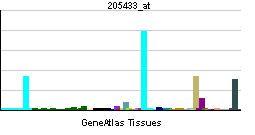Butyrylcholinesterase
| Butyrylcholinesterase | |||||||||||||
|---|---|---|---|---|---|---|---|---|---|---|---|---|---|
 PDB rendering based on 1p0i. | |||||||||||||
| |||||||||||||
| Identifiers | |||||||||||||
| Symbols | BCHE ; CHE1; E1 | ||||||||||||
| External IDs | Template:OMIM5 Template:MGI HomoloGene: 20065 | ||||||||||||
| EC number | 3.1.1.8 | ||||||||||||
| |||||||||||||
| RNA expression pattern | |||||||||||||
 | |||||||||||||
| More reference expression data | |||||||||||||
| Orthologs | |||||||||||||
| Template:GNF Ortholog box | |||||||||||||
| Species | Human | Mouse | |||||||||||
| Entrez | n/a | n/a | |||||||||||
| Ensembl | n/a | n/a | |||||||||||
| UniProt | n/a | n/a | |||||||||||
| RefSeq (mRNA) | n/a | n/a | |||||||||||
| RefSeq (protein) | n/a | n/a | |||||||||||
| Location (UCSC) | n/a | n/a | |||||||||||
| PubMed search | n/a | n/a | |||||||||||
Butyrylcholinesterase, also known as BCHE, is a human gene. Butyrylcholinesterase is also called serum cholinesterase. It is very similar to the neuronal acetylcholinesterase. Butyrylcholine is a synthetic compound and does not occur in the body naturally. It is used as a tool to distinguish between acetyl- and butyrylcholinesterase.
Mutant alleles at the BCHE locus are responsible for suxamethonium sensitivity. Homozygous persons sustain prolonged apnea after administration of the muscle relaxant suxamethonium in connection with surgical anesthesia. The activity of pseudocholinesterase in the serum is low and its substrate behavior is atypical. In the absence of the relaxant, the homozygote is at no known disadvantage.[1]
See also
References
Further reading
- Lockridge O (1989). "Structure of human serum cholinesterase". Bioessays. 9 (4): 125–8. doi:10.1002/bies.950090406. PMID 3067729.
- Allderdice PW, Gardner HA, Galutira D; et al. (1992). "The cloned butyrylcholinesterase (BCHE) gene maps to a single chromosome site, 3q26". Genomics. 11 (2): 452–4. PMID 1769657.
- Gaughan G, Park H, Priddle J; et al. (1992). "Refinement of the localization of human butyrylcholinesterase to chromosome 3q26.1-q26.2 using a PCR-derived probe". Genomics. 11 (2): 455–8. PMID 1769658.
- Arpagaus M, Kott M, Vatsis KP; et al. (1990). "Structure of the gene for human butyrylcholinesterase. Evidence for a single copy". Biochemistry. 29 (1): 124–31. PMID 2322535.
- Nogueira CP, McGuire MC, Graeser C; et al. (1990). "Identification of a frameshift mutation responsible for the silent phenotype of human serum cholinesterase, Gly 117 (GGT----GGAG)". Am. J. Hum. Genet. 46 (5): 934–42. PMID 2339692.
- McGuire MC, Nogueira CP, Bartels CF; et al. (1989). "Identification of the structural mutation responsible for the dibucaine-resistant (atypical) variant form of human serum cholinesterase". Proc. Natl. Acad. Sci. U.S.A. 86 (3): 953–7. PMID 2915989.
- Prody CA, Zevin-Sonkin D, Gnatt A; et al. (1987). "Isolation and characterization of full-length cDNA clones coding for cholinesterase from fetal human tissues". Proc. Natl. Acad. Sci. U.S.A. 84 (11): 3555–9. PMID 3035536.
- Lockridge O, Adkins S, La Du BN (1987). "Location of disulfide bonds within the sequence of human serum cholinesterase". J. Biol. Chem. 262 (27): 12945–52. PMID 3115973.
- McTiernan C, Adkins S, Chatonnet A; et al. (1987). "Brain cDNA clone for human cholinesterase". Proc. Natl. Acad. Sci. U.S.A. 84 (19): 6682–6. PMID 3477799.
- Lockridge O, Bartels CF, Vaughan TA; et al. (1987). "Complete amino acid sequence of human serum cholinesterase". J. Biol. Chem. 262 (2): 549–57. PMID 3542989.
- Jbilo O, Toutant JP, Vatsis KP; et al. (1994). "Promoter and transcription start site of human and rabbit butyrylcholinesterase genes". J. Biol. Chem. 269 (33): 20829–37. PMID 8063698.
- Mattes C, Bradley R, Slaughter E, Browne S (1996). "Cocaine and butyrylcholinesterase (BChE): determination of enzymatic parameters". Life Sci. 58 (13): PL257–61. PMID 8622553.
- Iida S, Kinoshita M, Fujii H; et al. (1996). "Mutations of human butyrylcholinesterase gene in a family with hypocholinesterasemia". Hum. Mutat. 6 (4): 349–51. doi:10.1002/humu.1380060411. PMID 8680411.
- Kamendulis LM, Brzezinski MR, Pindel EV; et al. (1996). "Metabolism of cocaine and heroin is catalyzed by the same human liver carboxylesterases". J. Pharmacol. Exp. Ther. 279 (2): 713–7. PMID 8930175.
- Hidaka K, Iuchi I, Tomita M; et al. (1998). "Genetic analysis of a Japanese patient with butyrylcholinesterase deficiency". Ann. Hum. Genet. 61 (Pt 6): 491–6. doi:10.1046/j.1469-1809.1997.6160491.x. PMID 9543549.
- Browne SP, Slaughter EA, Couch RA; et al. (1998). "The influence of plasma butyrylcholinesterase concentration on the in vitro hydrolysis of cocaine in human plasma". Biopharmaceutics & drug disposition. 19 (5): 309–14. PMID 9673783.
- Altamirano CV, Lockridge O (1999). "Conserved aromatic residues of the C-terminus of human butyrylcholinesterase mediate the association of tetramers". Biochemistry. 38 (40): 13414–22. PMID 10529218.
- Darvesh S, Kumar R, Roberts S; et al. (2002). "Butyrylcholinesterase-Mediated enhancement of the enzymatic activity of trypsin". Cell. Mol. Neurobiol. 21 (3): 285–96. PMID 11569538.
- Barta C, Sasvari-Szekely M, Devai A; et al. (2002). "Analysis of mutations in the plasma cholinesterase gene of patients with a history of prolonged neuromuscular block during anesthesia". Mol. Genet. Metab. 74 (4): 484–8. doi:10.1006/mgme.2001.3251. PMID 11749053.
| This protein-related article is a stub. You can help Wikipedia by expanding it. |